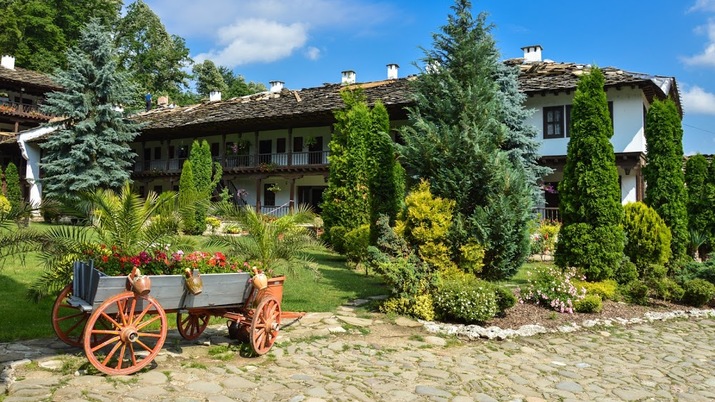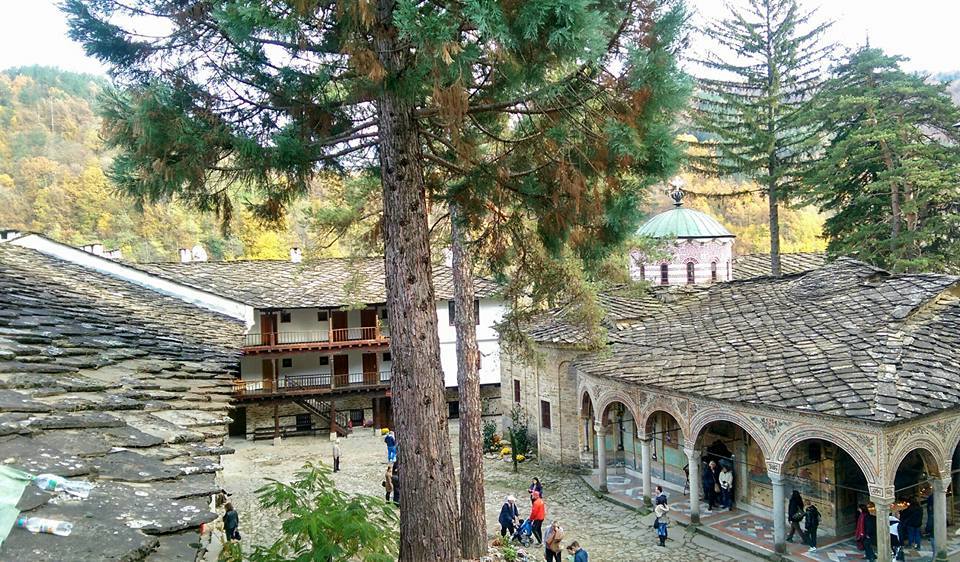Troyan monastery
Troyan Monastery “Assumption of the Holy Mother” is located in the northern part of the Troyan Balkan on the banks of the Cherni Osam River, 10 km away from the town of Troyan and very close to the village of Oreshak. It was founded at the end of the 16th century and is the largest monastery in Stara Planina mountain and the third largest spiritual center in Bulgaria (after Bachkovo and Rila monasteries). It is a complex of a church, residential and farm buildings, and two hermitages – “St. Nicholas” and “St. John the Baptist”. The miraculous icon “St. Virgin Mary of the Three Hands” is kept inside it. The monastery is stauropegic to the Bulgarian Orthodox Church, i.e. it is under the direct jurisdiction of the supreme ecclesiastical authority in the country – the Holy Synod.
There is not enough data about its early history. It is not known whether the monastery existed in the Middle Ages. Based on later information, some researchers believe that it was founded around the beginning of the 17th century by an unknown hermit monk who built the small wooden church “Nativity of the Virgin Mary” near Osam River. It is noted in a monastery chronicle:

“The beginning of the existence of the Troyan monastery was many years after the collapse of the Bulgarian kingdom. A monk appeared – a Bulgarian unknown by name. He came from an unknown country and settled in the mountain desert with his only neophyte. And by building a simple hut for himself and living in it for many years he became known to the ordinary people in this area.”
A legend tells of a hieromonk from Mount Athos who – on his way to Wallachia – passed by here carrying with him a miraculous icon of the Holy Mother. Learning that a pious hermit lived in the Troyan Mountains, the Athos monk sought him out and the two spent some time together in fasting exploits. People from near and far flocked to worship the holy icon and saw many miracles. When it was time to continue on his way, he had not yet left the yard and his horse stumbled and fell. The priest postponed his journey but when he set out again his horse fell to the ground again at the gates. In that he saw a sign of God realizing that the icon did not want to leave the place. The hermit invited him to stay to serve God together but the monk of Mount Athos preferred to stay away from Turkish arbitrariness. He said goodbye to the icon and to his host and left only with God in his heart. The Troyan hermit was soon joined by several other brothers, they built a small wooden church for the icon of the Holy Mother and began to serve in it. The number of pilgrims grew, and soon cells were built for them, and so the Troyan Monastery arose. The glory of the miraculous icon of the Most Holy Mother of God with Three Hands spread far and wide because it gave healing not only to the believing Christians but also to the Turks who came with serenity and hope.
The Troyan monastery grew rapidly. Very soon a wooden church dedicated to the Nativity of the Virgin Mary, a monastic residential wing and a small inn were built. Not long after, however, the monastery was desecrated by a Turkish gang and the abbot was beheaded.

The history of Troyan Monastery in the XVII-XIX centuries is a long series of pogroms and robberies by the enslavers. The monastery has survived thanks to patriotic and vigilant monks and the support of freedom-loving Balkan people from the surrounding villages and huts – the nascent artisanal class. Throughout its existence, the Troyan Monastery has been a local center of spirituality, education and literacy. The monks of the monastery have always had close contact with the people, supported their thirst for spiritual and political freedom.
The people’s protectors – the hayduts – also found refuge here, and several times in his patriotic activity behind his walls the Apostle of Freedom Vasil Levski also struggled. Here he founded the country’s first monastic revolutionary committee. During the outbreak of the April Uprising, a command post of the voivodes Panayot Volov, Georgi Ikonomov and Toma Hitrov was organized in the monastery. To present days, the cell in which the revolutionary affairs were discussed has been preserved in its authentic form. During the Russo-Turkish War of Liberation, the complex was transformed into an infirmary for Russian soldiers.

Another architectural monument in the monastery was erected in 1865 – the bell tower whose outside walls were covered with decorative and monumental paintings. Here the first Troyan painter Pecho Hadji-Naidenov painted unseen until then ornamental compositions, figures of archangels and saints-pillars. The chapel “Golgotha” which is located on its first floor is also worth seeing. It was renovated and decorated with the very popular during the First and Second Bulgarian Kingdom mosaic technique which is almost not used today.
With its architecture, woodcarving, artistic decoration, icons, frescoes, the Troyan Monastery has influenced the development of crafts in the Troyan region – pottery and carving. Apart from being a religious-educational and rebellious center, the monastery is also known for its developed animal husbandry and agriculture, especially fruit growing, where the plum culture stands out. The monk brothers produced plum brandy of enviable quality which was awarded a bronze medal and a diploma at an exhibition in Belgium in 1894.
When in the first half of the 18th century the monastery grew and became economically wealthy, a cell school began to function in it. In 1869 it grew into a secular one and children from nearby villages studied there. The Troyan Monastery became the center of Bulgarian education and literacy.
At the beginning of the 19th century the monastery was already quite large. The residential buildings surrounding the yard are built of Revival-style wood. They are two-storey and even three-storey – something extremely rare for the era. In the northwest corner there is a residential and defensive tower.
The most significant cultural monument in the Troyan monastery is the Church of the Assumption of the Holy Mother. Located in the south courtyard, among two-storey and three-storey bay window residential buildings, it is the colorful architectural center of the ensemble. About its original appearance and the buildings around it, we judge by a stamp from 1839 and from the description and drawings of the Hungarian traveler Felix Kanitz.
For painting of the newly built church in 1847 the famous Renaissance artist Zachary Zograf was invited. His are the frescoes on the inner walls of the temple – with bright colored harmonies and many rare plots. He left on the north inner wall donor portraits and his self-portrait, and on the north outer wall – the composition Wheel of Life.
Today in the monastery church “The Holy Mother” is the tomb of the former Bulgarian patriarch Maxim (1914-2012). At his express request, he was buried in his favorite Trojan monastery where his neophyte’s years had passed.
In addition to the interesting architecture and the valuable frescoes, the Troyan Monastery also offers an impressive museum collection where you can see many objects of applied arts and crafts, valuable literary monuments and even buckles donated by Raina Knyaginya. You can visit the room of Tsar Boris III and a Troyan living room that has preserved the atmosphere of 140 years ago.
On the temple holiday of the monastery – Assumption of the Holy Mother (August 15), thousands of pilgrims flock to it from the country and abroad. Then a craft fair with over 150 years of history was held near its walls. There is a convenient bus service there every hour. Admission for visitors is free, and there is a possibility to stay over night in the monastery itself.
